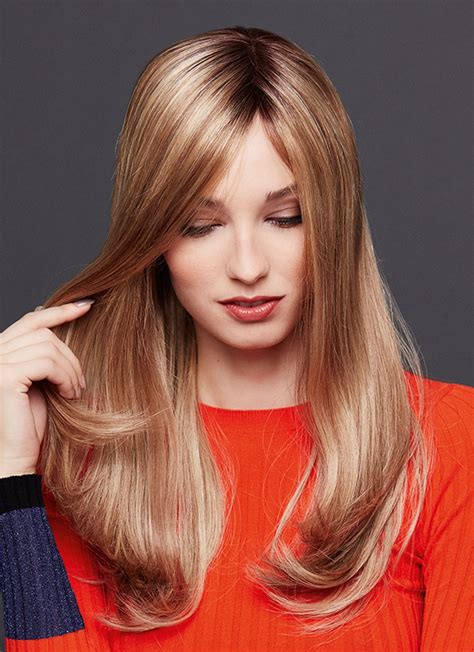Introduction
Wigs have become increasingly popular among women of all ages and backgrounds, offering versatility and a way to enhance their natural appearance. For white women, human hair wigs provide an exceptional option, allowing them to achieve a realistic and natural-looking transformation. This comprehensive guide delves into the world of human hair wigs for white women, exploring the types, benefits, and essential factors to consider when selecting the perfect wig.

Types of Human Hair Wigs for White Women
Human hair wigs come in a wide variety of styles and constructions, catering to different preferences and hair textures. Here are the most common types:
- Lace Front Wigs: These wigs feature a sheer lace piece at the hairline, which creates a seamless and undetectable appearance.
- Full Lace Wigs: As the name suggests, these wigs have a lace cap that extends from the hairline to the nape of the neck, providing a natural scalp-like appearance.
- 360 Lace Wigs: Similar to full lace wigs, 360 lace wigs have a lace cap that covers the entire head, except for a small area at the crown.
- Wefted Wigs: These wigs are made from wefts of hair that are sewn onto a breathable cap, offering durability and versatility.
- Monofilament Wigs: These wigs use a thin, transparent mesh cap that conceals the knots where the hair is attached, resulting in a realistic scalp appearance.
Benefits of Human Hair Wigs for White Women
Human hair wigs offer numerous benefits for white women, including:
- Natural Appearance: Human hair wigs are renowned for their exceptional ability to mimic the texture, color, and shine of natural hair, making them virtually indistinguishable.
- Styling Versatility: Human hair wigs can be styled and colored like real hair, providing endless possibilities for customization.
- Long-Lasting: With proper care and maintenance, human hair wigs can last for up to two years, offering excellent value for money.
- Enhancement of Hair Density and Volume: Human hair wigs can add volume and fullness to thinning or fine hair, creating a more youthful and flattering appearance.
- Protection from Sun Damage and Heat Styling: Wigs act as a barrier between natural hair and environmental aggressors, protecting it from UV rays and heat damage.
Factors to Consider When Selecting a Human Hair Wig for White Women
Choosing the right human hair wig requires careful consideration of several factors:
- Hair Texture: Match the texture of the wig to your natural hair for a seamless blend.
- Hair Density: Select a wig with the appropriate density to complement your natural hair thickness.
- Hair Color: Opt for a wig color that closely resembles your natural shade or complements your skin tone.
- Cap Construction: Choose a cap construction that suits your scalp sensitivity, comfort level, and desired appearance.
- Budget: Set a realistic budget and consider the cost of the wig, maintenance, and styling.
Common Mistakes to Avoid When Wearing Human Hair Wigs for White Women
- Overstyling: Excessive styling can damage the wig and shorten its lifespan.
- Improper Care: Neglecting regular maintenance, such as washing, conditioning, and detangling, can lead to matting and breakage.
- Poor Fit: Wearing a wig that is too tight or too loose can cause discomfort and damage the hair.
- Insufficient Ventilation: Wigs can trap heat and cause scalp irritation. Ensure proper ventilation by avoiding wearing wigs for extended periods without breaks.
- Lack of Customization: Failing to personalize the wig to suit your individual preferences can result in an unnatural or unflattering appearance.
Comparison of Pros and Cons of Human Hair Wigs for White Women
Pros:
- Natural appearance
- Styling versatility
- Long-lasting
- Enhanced hair density and volume
- Protection from sun damage and heat styling
Cons:
- Expensive
- Requires regular maintenance
- Can be damaged by improper care
- Not as breathable as synthetic wigs
- May require professional styling for optimal results
FAQs about Human Hair Wigs for White Women
- How often should I wash a human hair wig? Every 1-2 weeks, depending on usage and styling frequency.
- Can I dye a human hair wig? Yes, but it is recommended to consult a professional hairstylist to avoid damage.
- How long do human hair wigs last? With proper care, up to two years.
- How can I maintain a human hair wig? Wash, condition, detangle, and style regularly. Avoid heat styling and overprocessing.
- How do I choose the right human hair wig? Consider hair texture, density, color, cap construction, and budget.
- Can I wear a human hair wig every day? For optimal health and longevity, it is recommended to give your scalp a break from wearing wigs several times a week.
- Is it possible to customize a human hair wig? Yes, you can have it cut, colored, and styled to suit your preferences.
- How much does a human hair wig cost? Prices range depending on length, quality, construction, and brand, but can start from around $200.
Conclusion
Human hair wigs for white women offer an exceptional way to enhance their natural appearance, with benefits ranging from increased hair density to protection from sun damage. By considering the factors outlined in this guide and avoiding common mistakes, white women can select and wear human hair wigs with confidence and style. Embrace the transformative power of human hair wigs and unlock a world of limitless possibilities for your hair!
